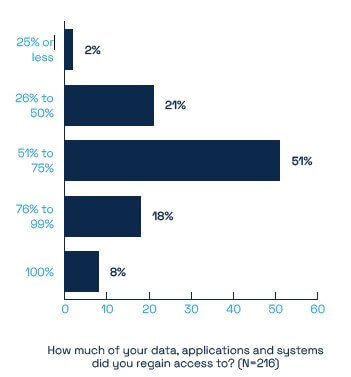In our recent research, a majority of respondents indicated a willingness to pay a ransom after a cyberattack in order to regain access to their applications and data. It is essential to emphasize that the focal point of concern I will focus on today is not merely whether the ransom was paid, but rather the outcomes that followed for those who did remit payment. By the way, 54% of the respondents we surveyed admitted to paying a ransom — a very high number, in my opinion.
Survey Says….

As the chart shows, our research indicates that only 8% of respondents who paid a ransom successfully
recovered 100% of their data and applications. Furthermore, more than 50% recovered between 51% and 75% of their data and applications, which signifies a considerable loss of access to essential information for many users.
Wrapping Up
These statistics are particularly alarming and underscore the gravity of the issue. It is evident that paying a ransom does not guarantee a successful recovery and is more likely to result in an incomplete — and potentially very costly in terms of time and resources — recovery.
It is well known that many organizations contract ransomware/cyber insurance only to be told to pay the ransom (assuming it will be covered). What a bad idea! It is not prudent to pay a ransom with the expectation that it will ensure the restoration of one’s data. There’s no magic bullet: Building cyber-recoverability in your infrastructure is critical.


